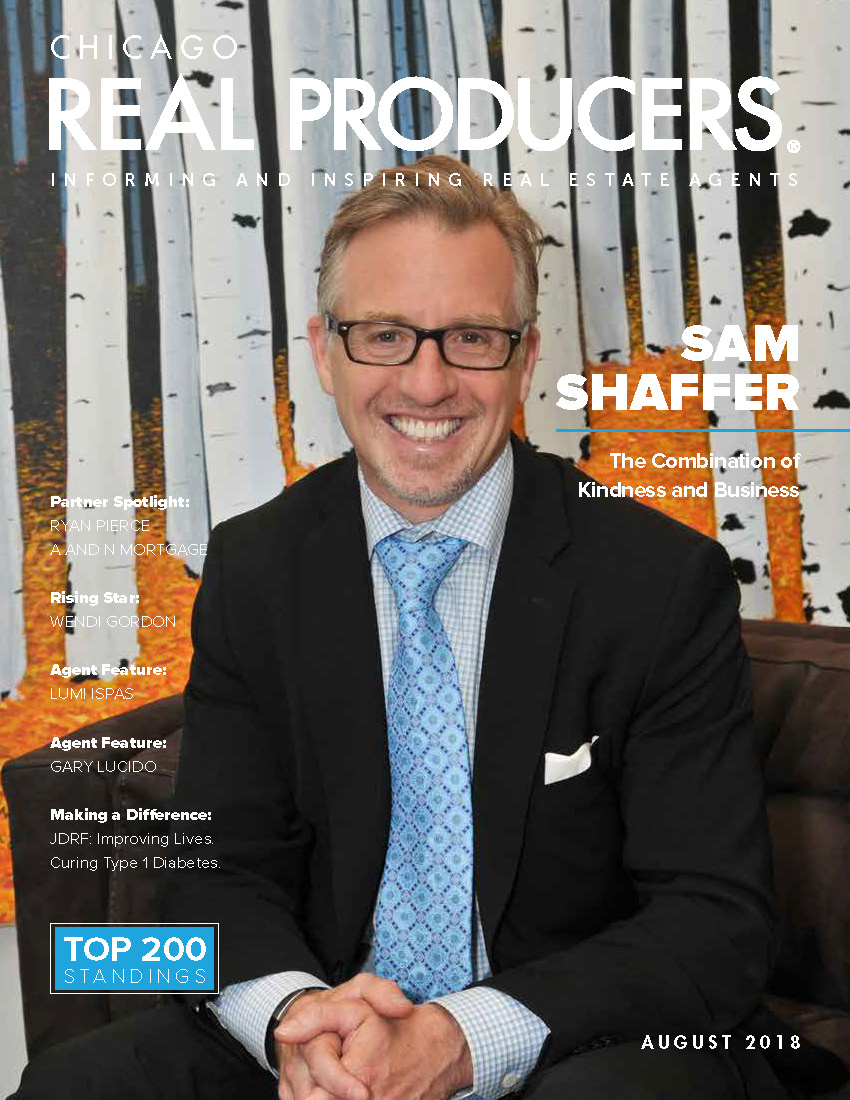We are pleased to announce that we were able to contribute an article in the August 2018 issue of Chicago Real Producers magazine. This is the first article in a series of three to be published by the magazine this coming Fall. In the article, Hasani discusses misconceptions about specific neighborhoods on Chicago’s South Side, how to approach buying and selling in emerging markets, and educating your clients as well as other common themes in the scope of real estate.
Featured on the cover is Chicago Realtor and Broker Sam Shaffer of Chicago Properties. Sam is on the Chicago Association of Realtors list of top 1 percent of producers.
See the full transcript below:
Navigating the South Side
I am delighted for the opportunity from Andy and the Real Producers team to share with my respected colleagues a three-part series about my South Side industry experience. In this first article, I will discuss some of the common negative concerns and objections regarding Chicago’s South Side brand. Many of these concerns and objections apply to other emerging or re-emerging neighborhoods throughout Chicagoland. With the strengthening economy, more established neighborhoods will increase in price and, consequently, adjacent neighborhoods will emerge and be considered by purchasers not familiar with those neighborhoods.
So, you have a client who is interested in the value that Chicago’s South Side has to offer, but they lack a complete picture. Many times there can be a flood of varying questions:
“Where is Englewood? Is it close by?”
“How do I know if this time is right for buying/investing?”
“Who else is buying in this development?”
“Obama lives here?”
Clients seek direct, simple, easy-to-understand answers when performing their due diligence. It can be an awkward situation for anyone, but especially for a licensed Realtor, and we know not to chance putting our license in jeopardy! Selling in emerging markets starts with finding common ground and making comparisons to what people know. I create analogies to put things in perspective for clients. The existing Chicago South Side brand as a whole doesn’t accurately represent all of what it has to offer. We jokingly call the South Side the “Soft Side” in that it brings awareness to things other than the violence that it is associated within the media today.
From a personal standpoint, when it comes to communicating well with my clients, I am fortunate to draw from a diverse background and many experiences of and within different neighborhoods and economic classes. My maternal grandfather raised his family in Bronzeville and later owned property at 67th & Champlain. My paternal grandfather was a WW2 veteran and began his family in Altgeld Gardens. They later moved to a home at 73rd & University. My father and mother moved to the South Shore (71st & Chappel) shortly after marriage, then on to suburbs after that. Although I grew up in the ‘burbs (my parents took some pretty big steps to have access to the excellent public schools, and other opportunities, for which I’m grateful), I had a well-rounded childhood as I spent much time on the South Side visiting cousins during holidays and the summer.
I know, first hand, that the South Side is emerging, and to sell there, it takes more of a hands-on approach. You must educate people on several aspects of the different neighborhoods. And creating parallels to what people already know is an effective tool. As an example, let’s think about the evolution of the North Side: Halsted was once a cutoff point, then it was Ashland, Damen, Western, and so forth. Wicker Park had its challenges years ago (and still does to some extent) but now it has every cool restaurant and is rich with cultural diversity. It’s a true example of organic growth. On the South Side, east of Drexel Avenue is like being east of Halsted. West of I-94 is like what the west side of Western once was. Like many Chicago neighborhoods, the South Side can be block-by-block. Using these kinds of parallels when working with someone from the North Side can effectively give your audience a mental picture. (I use this same approach when selling in the suburbs.)
Furthermore, think about how the South Side was once a major destination and how it is growing again. It has a history rich in treasures. As you may know, it was the site of the World’s Fair — the Museum of Science & Industry is a reminder of that. I like to think of it as the “first settled Gold Coast” with the millionaires of the time calling it home. More recently, President Obama was a long-time resident of Hyde Park and there is an undeniable Chicago economy that many do not know exists today. Ultimately, people have to understand that there’s a lot more to offer in these areas than they may know of, especially considering the major developments and those on the horizon. Examples include the Obama Presidential Campus, the proposed Tiger Woods Golf Course, Bronzeville continually being noted as a “hot neighborhood” by various media outlets, and Woodlawn winning “Neighborhood of the Year” by Curbed Chicago in 2016.
As brokers, no matter where we’re selling, it’s our job to take on the negative stereotypes of neighborhoods that arise from the media. On the South Side, these stereotypes relate to the media’s focus on crime, police brutality, and related news. We take on many roles and can be classified, in one sense, as translators. My calling has always been to accept challenges. What helps me throughout the process of working through my clients’ concerns is to seek understanding in everything. That approach facilitates authenticity and creativity in how I educate my clients on neighborhood evolution.
I truly believe the South Side is a hidden treasure. There is a high concentration of incredible people serving their community. Navigating the negative stereotypes is a true challenge, but as the saying goes, “With great risk, comes great reward.”
Right now, buyers are purchasing homes more for the properties themselves and less for what the area has to offer today in terms of commercial development. So, it’s important to understand that the product itself — the property, the house — must be thoughtful, refined, and tailored to the client’s tastes. People WILL pay for that —many want to live on the South Side, but they want a quality home. Those homes are available on the South Side, and realtors willing to take a hands-on approach and educate their clients can tap into the economic growth of the area. As they said in Field of Dreams, “If you build it, they will come!”
What questions do you have about South Side real estate? What questions do you get from your buyers and sellers about the area?
Email my team at [email protected], and I’ll address them in the next article. I welcome your thoughts — this is a complex conversation with plenty to discuss!



